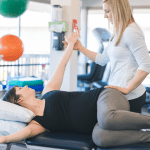The Impact of Menopause on the Pelvic Floor
Menopause marks a significant transition in a woman’s life, often accompanied by various physiological changes. One area that is notably affected is the pelvic floor, a group of muscles, ligaments, and connective tissues that support the pelvic organs. During menopause, hormonal fluctuations, particularly the decrease in estrogen, can lead to the thinning of tissues and weakening of the pelvic floor muscles. This weakening can result in a range of symptoms and conditions that can significantly impact a woman’s quality of life.
Symptoms of Pelvic Floor Weakening
As the pelvic floor weakens, women may experience a variety of symptoms. These can include urinary incontinence, where there is involuntary leakage of urine, often triggered by coughing, sneezing, or physical activity. Another symptom is pelvic organ prolapse, where organs such as the uterus or bladder descend from their normal position, sometimes causing a bulge in the vagina. Women may also face challenges with sexual function, experiencing discomfort or pain during intercourse, reduced sensation, or difficulty achieving orgasm.
Factors Contributing to Pelvic Floor Issues
Several factors can contribute to the weakening of the pelvic floor in addition to menopause. These include chronic coughing, constipation, and being overweight, all of which place additional strain on the pelvic muscles. Furthermore, a history of childbirth can also have a lasting impact on pelvic floor integrity. It is important to recognize these contributing factors as they can exacerbate menopausal symptoms and lead to further complications if not addressed.
Long-Term Consequences of Neglected Pelvic Health
Neglecting pelvic health can lead to long-term consequences that extend beyond discomfort. Chronic pelvic floor issues can lead to social isolation, reduced sexual activity, and even depression. The physical discomfort and the psychological impact of conditions like urinary incontinence and pelvic organ prolapse can significantly diminish a woman’s quality of life. Therefore, it is crucial to address pelvic floor health proactively to prevent these long-term consequences.
Understanding the relationship between menopause and pelvic floor health is the first step towards managing and improving symptoms. With proper care, including exercises like Kegels, lifestyle adjustments, and medical interventions when necessary, women can maintain pelvic floor strength and function, leading to a healthier and more comfortable menopausal transition.
The Role of Kegel Exercises in Menopausal Health
Benefits of Kegel Exercises for Menopause
Menopause brings significant changes to a woman’s body, one of which is the weakening of the pelvic floor muscles. Kegel exercises, named after Dr. Arnold Kegel who developed them, are designed to strengthen these muscles, offering numerous benefits during menopause. Improved pelvic floor strength can lead to better bladder control, reduced risk of uterine prolapse, and enhanced sexual function. Regular Kegel exercises can also alleviate symptoms such as urinary incontinence, which often leads to social isolation and emotional distress. By incorporating Kegels into their daily routine, women can significantly improve their quality of life during and after the menopausal transition.
Kegels as a First-Line Treatment for Incontinence
Urinary incontinence (UI) is a common concern for menopausal women, affecting their confidence and lifestyle. The American College of Physicians endorses Kegel exercises as a first-line treatment for UI. These exercises strengthen the pelvic floor muscles, providing better support for the bladder and urethra. This increased muscle tone can help prevent involuntary leakage, especially during physical activities such as coughing, sneezing, or exercising. A 2018 study highlighted that consistent practice of pelvic floor training, including Kegels, not only reduced the number of leakage episodes but also the amount of leakage, offering a potential cure for stress urinary incontinence.
Improving Sexual Function with Kegel Exercises
Menopause can also impact sexual health, causing issues like vaginal dryness, discomfort during intercourse, and decreased libido. Kegel exercises can play a pivotal role in improving sexual function by enhancing blood circulation to the pelvic region, which may boost arousal and natural lubrication. Additionally, the strengthening and increased awareness of pelvic floor muscles can contribute to more pleasurable sexual sensations and potentially better orgasms. A randomized trial found that Kegel exercises were more effective in improving sexual function in menopausal women compared to the use of lubricant gel, underscoring the importance of these exercises in maintaining sexual wellness.
Addressing Pain and Discomfort
Menopausal women often experience pelvic pain and discomfort due to hormonal changes and weakened pelvic muscles. Kegel exercises can help address these symptoms by promoting relaxation and increasing muscle control in the pelvic area. By practicing Kegels, women can learn to manage tight vaginal muscles that contribute to painful intercourse, thus improving their overall comfort. It is essential, however, to seek medical evaluation for pain during sex to rule out other causes such as UTIs or muscle spasms before relying solely on Kegel exercises as a remedy.
In conclusion, Kegel exercises are a simple yet powerful tool for managing various menopausal symptoms. They offer a non-invasive way to strengthen the pelvic floor, improve bladder control, enhance sexual function, and reduce discomfort. With regular practice and proper technique, Kegel exercises can be a cornerstone of a healthier menopause experience.

Overcoming Barriers to Discussing Pelvic Health
The Importance of Open Communication with Healthcare Providers
Discussing pelvic health, particularly during and after menopause, is crucial for maintaining overall well-being. Open communication with healthcare providers about pelvic floor issues is essential for early detection and effective management. Healthcare professionals are equipped to assess pelvic floor dysfunction, which can manifest as urinary incontinence, pelvic organ prolapse, and sexual dysfunction. By fostering a dialogue, women can receive personalized advice on Kegel exercises, which are proven to strengthen the pelvic floor and alleviate symptoms.
Unfortunately, many women hesitate to initiate conversations about pelvic health due to embarrassment or the misconception that symptoms are a normal part of aging. It is vital for healthcare providers to create a supportive environment that encourages patients to share their concerns without fear of judgment. This can be achieved through reassurance, education, and the normalization of pelvic health discussions.
Challenges in Seeking Help for Pelvic Floor Issues
Despite the known benefits of Kegel exercises for menopausal health, many women face barriers in seeking help for pelvic floor issues. These challenges include:
- Lack of Awareness: A significant number of women are unaware of the importance of pelvic floor health and the existence of beneficial exercises like Kegels.
- Social Stigma: Cultural taboos and stigma surrounding discussions of pelvic health can prevent women from seeking help or even acknowledging their symptoms.
- Insufficient Education: Some healthcare providers may not fully address pelvic health during routine consultations, missing opportunities to educate patients on preventive measures and treatments.
- Accessibility: Access to specialized pelvic floor therapy may be limited by geographical location, availability of trained professionals, or financial constraints.
To overcome these barriers, healthcare systems must prioritize pelvic health as a key component of women’s healthcare. This includes training for primary care providers, integrating pelvic health into routine check-ups, and providing resources for self-help and support groups. Additionally, public health campaigns can play a significant role in raising awareness and destigmatizing pelvic floor dysfunction.
Empowering women with knowledge and resources is the cornerstone of improving menopausal health. By addressing the challenges in discussing and seeking help for pelvic floor issues, we can ensure that more women benefit from the protective and restorative effects of Kegel exercises.
Scientific Evidence Supporting Kegel Exercises
Research on Kegels and Quality of Life
Menopause brings a myriad of changes, including the weakening of the pelvic floor muscles, which can lead to symptoms such as urinary incontinence and sexual dysfunction. Kegel exercises, which involve the rhythmic contraction and relaxation of pelvic floor muscles, have been studied for their potential benefits in improving these menopausal symptoms and, consequently, the quality of life.
A 2018 study published in Clinical Interventions in Aging examined 2,394 women with urinary incontinence and found that pelvic floor training, including Kegels, significantly improved the participants’ quality of life. The study highlighted the profound impact urinary incontinence can have on a person’s lifestyle, increasing the risk of isolation, reduced sexual activity, and depression. By incorporating Kegel exercises into their routine, women reported a notable improvement in their ability to manage incontinence, leading to enhanced well-being and social engagement.
Cochrane Review Findings on Pelvic Floor Training
The Cochrane Review, renowned for its rigorous analyses of healthcare interventions, conducted a review in October 2018 that concluded pelvic floor training could “reduce the number of leakage episodes” and the amount of leakage experienced by individuals. The review went so far as to consider pelvic floor training a potential cure for stress urinary incontinence. This endorsement by the Cochrane Review underscores the scientific community’s recognition of Kegel exercises as a viable and non-invasive treatment option for urinary incontinence.
Furthermore, a randomized trial conducted in Dezful, Iran, compared the effectiveness of Kegel exercises and lubricating gel on sexual function in menopausal women. The results indicated that both interventions improved sexual function, but Kegel exercises had a higher odds ratio for better outcomes, suggesting a more significant improvement in sexual function compared to the use of lubricant gel alone.
Another systematic review, published in Healthcare (Basel) in January 2023, focused on postmenopausal women with urinary incontinence. It concluded that pelvic floor muscle exercises are a highly recommended treatment, with all included studies reporting significant improvements in strength, quality of life, and severity of urinary incontinence.
These findings collectively affirm the role of Kegel exercises in enhancing pelvic health and quality of life for menopausal women. With the backing of scientific evidence, Kegel exercises stand out as a first-line, non-pharmacological treatment for urinary incontinence and a contributor to improved sexual function.

THEN IT CONTAINS TOXIC CHEMICALS. WHY RISK IT GETTING SICK? GO CHEMICAL FREE.
Proper Technique for Performing Kegel Exercises
Identifying the Correct Muscles
To effectively perform Kegel exercises, it is crucial to first identify the correct muscles. These are the same muscles you would use to stop the flow of urine or prevent passing gas. A common method to locate these muscles is to insert a clean finger into the vagina and try to squeeze the surrounding muscles. You should feel the pelvic floor muscles tightening and your finger being squeezed if you are using the right muscles. Additionally, ensure you are not contracting your abdominal, thigh, or buttocks muscles during the process.
Step-by-Step Guide to Effective Kegels
- Find a comfortable position: You can perform Kegel exercises lying down, sitting, or standing.
- Relax: Make sure your bladder is empty, then find a comfortable position and relax your muscles.
- Focus on the pelvic floor: Concentrate on tightening only your pelvic floor muscles. Avoid holding your breath; instead, breathe freely during the exercises.
- Squeeze and hold: Tighten your pelvic floor muscles, hold the contraction for three to five seconds, and then relax for three to five seconds.
- Repeat: Aim for 10 repetitions, three times a day.
Common Mistakes to Avoid
When performing Kegel exercises, avoid these common mistakes:
- Contracting the abdominal, thigh, or buttocks muscles instead of the pelvic floor muscles.
- Holding your breath. Instead, breathe normally during the exercises.
- Overdoing it. Performing too many Kegels can lead to muscle fatigue and increase symptoms.
- Using Kegels to start and stop your urine stream regularly, as this can lead to incomplete emptying of the bladder, which increases the risk of a urinary tract infection.
Creating a Kegel Exercise Routine
Consistency is key to a successful Kegel exercise routine. Start by performing 10 repetitions, three times a day. As your muscles get stronger, you can increase the duration of the contractions and the number of repetitions. Incorporate Kegels into daily activities, such as during your commute, while watching TV, or while at your desk. Setting reminders can also help you maintain a regular routine. Remember, if you experience any pain or discomfort, or if you have symptoms of a tight pelvic floor, such as constipation or painful sex, it is important to consult with a healthcare provider.
When Kegel Exercises Aren’t Enough
Recognizing Moderate to Severe Symptoms
While Kegel exercises are beneficial for many women experiencing menopausal symptoms, there are instances when these exercises may not suffice, particularly in cases of moderate to severe pelvic floor weakening. Symptoms that may indicate a more serious condition include persistent urinary or fecal incontinence, pelvic organ prolapse, and chronic pelvic pain. These symptoms can significantly impact quality of life and may require more than just at-home exercises. It is crucial for women to monitor their symptoms and seek medical advice if they experience discomfort that interferes with daily activities or persists despite regular Kegel exercises.
Seeking Professional Pelvic Floor Therapy
When Kegel exercises alone do not alleviate symptoms, it may be time to consult a healthcare provider. A referral to a pelvic floor physical therapist can be particularly beneficial. These specialists are trained to assess and treat pelvic floor disorders with a variety of techniques, including manual therapy, biofeedback, and targeted exercise programs. Pelvic floor therapy can help improve motor control, coordination, strength, and muscle endurance, offering a more personalized and comprehensive approach to pelvic health.
Additional Treatments and Interventions
In addition to pelvic floor therapy, other treatments and interventions may be recommended depending on the severity of symptoms. These can include:
- Medications: To manage symptoms such as overactive bladder or to address hormonal deficiencies.
- Vaginal Pessaries: Devices inserted into the vagina to support prolapsed organs and alleviate associated symptoms.
- Hormone Therapy: To help maintain tissue health and manage menopausal symptoms.
- Surgical Interventions: For severe cases of prolapse or incontinence that do not respond to conservative treatments.
- Lifestyle Modifications: Weight management, dietary changes, and smoking cessation to reduce symptoms.
It is important for women to understand that while Kegel exercises are a valuable tool for maintaining pelvic floor health, they are not a panacea. Recognizing when additional help is needed and seeking appropriate medical care are key steps in managing pelvic health during menopause. By exploring a range of treatments and interventions, women can find the most effective strategies to alleviate their symptoms and improve their overall quality of life.
By the way, something for you, a little gift!!!
I am just in the middle of publishing my book. It’s about How women can balance their hormones. One part is about food and diet, of course.
Follow this link and enter your email.
I will send you this part of the book for free once the book is published. It has many concrete, practical tips and recipes and will help you feel better during menopause or times of Big hormonal fluctuations.
Annette, Damiva Lead for Health & Wellness

Empowering Women for a Healthier Menopause
Integrating Kegels into Daily Life
As women navigate the complexities of menopause, integrating Kegel exercises into daily routines can be a powerful tool for maintaining pelvic floor health. Kegels are not only beneficial for strengthening the pelvic muscles but also for enhancing overall well-being during this transitional phase. To seamlessly incorporate Kegels into daily life, women can perform these exercises during routine activities such as brushing teeth, waiting in line, or sitting at a desk. The simplicity of Kegels allows for discretion and flexibility, making it easier to commit to a regular practice. Establishing a consistent routine, perhaps with reminders on a phone or calendar, can help solidify this healthy habit.
Support and Resources for Pelvic Health
Access to support and resources is crucial for women seeking to improve their pelvic health during menopause. Many may benefit from joining support groups, either in-person or online, where they can share experiences and tips with others facing similar challenges. Educational resources, such as instructional videos and literature provided by healthcare professionals, can offer guidance on proper technique and progression of exercises. Additionally, apps dedicated to pelvic floor health can provide structured programs and track progress. It’s important for women to know that they are not alone and that a wealth of resources is available to assist them on their journey to a healthier menopause.
Advocating for Comprehensive Menopausal Care
Advocacy for comprehensive menopausal care is essential to ensure that women receive the support and treatment they need during this significant life stage. Women are encouraged to speak openly with their healthcare providers about their symptoms and concerns, including those related to pelvic floor health. By doing so, they can explore a range of treatment options tailored to their individual needs. Healthcare providers should be well-informed about the benefits of pelvic floor exercises and other non-invasive treatments to offer holistic care. Furthermore, advocating for increased awareness and education about menopause in the public sphere can help destigmatize the conversation around menopausal health and empower more women to seek the care they deserve.
Remember, the journey through menopause is unique for every woman, but with the right tools and support, it can be navigated with strength and confidence. Kegel exercises, along with a supportive community and comprehensive care, can play a significant role in empowering women to maintain their health and vitality during menopause and beyond.




















